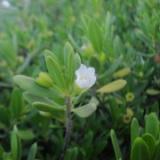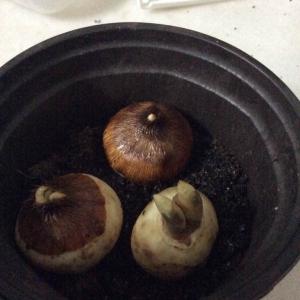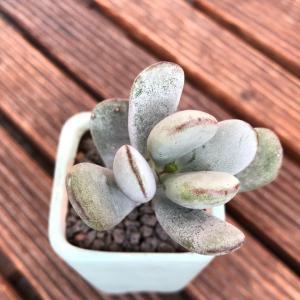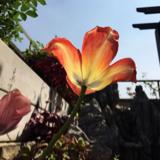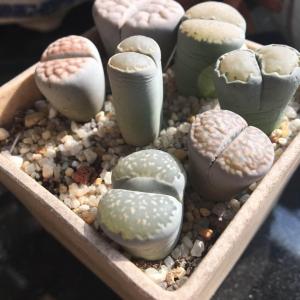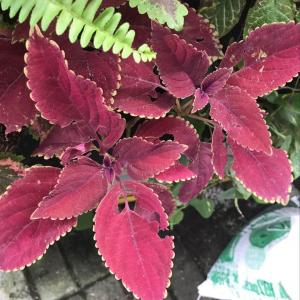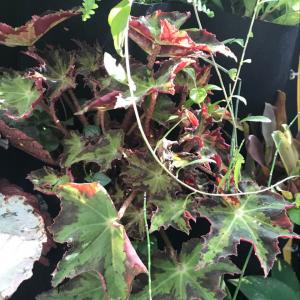文章
Miss Chen
2017年12月23日

Description: This herbaceous perennial plant is about 3' tall and normally erect, although it sometimes sprawls along the ground. The green central stem has fine white hairs, sometimes turning brown in response to drought. There are usually a few flowering side stems in the upper half of a large mature plant. The compound leaves consist of three leaflets that are greyish green. Each compound leaf has a short petiole with a pair of small deciduous sheaths at its base. The leaflets are 2-3½" long and less than half as wide. They are oblong or lanceolate in overall shape, but rounded at the tips rather than pointed. Their undersides have fine hooked hairs that cling to clothing or the fur of passing animals.

Numerous pink flowers in an elongated panicle occur at the end of one or more of the upper stems. The flowers are about ½" across (as measured vertically), consisting of an upper and a lower petal. These petals are initially folded and keel-like, but eventually open wide, begining with the upper petal. There is a small patch of dark pink at the center of the flower, from which emerges an upwardly curved white tube containing the stigmas and pistil. There is no floral scent. Each flower occurs on a hairy red pedicel, and has a hairy greenish red calyx.The blooming period occurs during mid-summer and lasts about 3 weeks. The flat seedpods have 3 to 5 segments and are about 2½" long. Like the undersides of the leaves, they are covered with fine hooked hairs, and are distributed by passing animals. Usually, the lower side of a seedpod is more rounded than the upper side. Technically, these seedpods are called 'loments.' The root system consists of a taproot that is long, slender, and brown.
Cultivation: The preference is full or partial sun, and moist to mesic conditions. A loamy soil with some organic matter is quite satisfactory. The foliage is often discolored by powdery mildew. This plant increases the nitrogen content of the soil by means of root nodules.
Central Stem & Trifoliate LeavesRange & Habitat: The native Showy Tick Trefoil occurs occasionally in most counties of central and northern Illinois, but is uncommon or absent in southern Illinois (see Distribution Map). Habitats include moist to mesic black soil prairies, moist meadows along rivers, borders of lakes, thickets, limestone glades, and areas along railroads where prairie remnants occur.
Faunal Associations: The most important visitors of the flowers are long-tongued bees, including bumblebees, Melissodes spp. (long-horned bees), and Megachile spp. (leaf-cutting bees). Only pollen is available as a floral reward (Robertson, 1929). Other insects feed on the foliage, seeds, and other parts of Showy Tick Trefoil and other Desmodium spp. (tick trefoils). These species include the seed-eating larvae of such weevils as Apion decoloratum and Apion reconditum; Odontota horni (Soybean Leafminer), Pachybrachis othonus, and other leaf beetles; larvae of such gall flies as Choristoneura hamata and Neolasioptera desmodii; Microparsus desmodiorum, Microparsus olivei, and other aphids; the seed-eating Megalotomus quinquespinosus (Lupine Bug); leaf-eating larvae of Atomacera debilis (an Argid sawfly); leaf-eating larvae of such moths as Caloptilia violacella and Parectopa lespedezaefoliella; leaf-eating larvae of such skippers as Thorybes bathyllus (Southern Cloudywing) and Thorybes pylades (Northern Cloudywing); larvae of two butterflies, Everes comyntas (Eastern Tailed Blue) and Strymon melinus (Gray Hairstreak); and Neohydatathrips desmodianus (Tick Trefoil Thrips). The flowering stems of Showy Tick Trefoil are a preferred food source of Popillia japonica (Japanese Beetle), which can weaken this plant sufficiently to interfere with the formation of seedpods. For a more complete list of these insect feeders, see the Insect Table. Like many other members of the Bean family, this plant is highly edible to various mammalian herbivores, including deer, rabbits, groundhogs, and livestock. Some upland gamebirds and small rodents eat the seeds, including the Bobwhite Quail, Wild Turkey, White-Footed Mouse, and Woodland Deer Mouse (Martin et al., 1951/1961; Hamilton, 1941). The seedpods can cling to the fur of mammals and clothing of humans, causing this plant to spread into new areas.
Photographic Location: Photographs were taken at Meadowbrook Park in Urbana, Illinois.
Comments: This is one of the showier Tick Trefoils because of the plentiful flowers, assuming it isn't marred by insects and disease. Showy Tick Trefoil is more attractive when it occurs in colonies, rather than as isolated plants. Distinguishing the different Desmodium spp. is rather difficult. Important features to consider are the number of segments and shape of the loments, and the size and structure of the compound leaves. Showy Tick Trefoil can be distinguished from Desmodium illinoense (Illinois Tick Trefoil) by examining the base of the compound leaves. The leaf-stem (primary petiole) connecting the compound leaf to the stem is much shorter in the former species than the latter species. Similarly, the leafy bracts at the base of the leaf-stem are smaller and more deciduous in the former species than the latter species.

Numerous pink flowers in an elongated panicle occur at the end of one or more of the upper stems. The flowers are about ½" across (as measured vertically), consisting of an upper and a lower petal. These petals are initially folded and keel-like, but eventually open wide, begining with the upper petal. There is a small patch of dark pink at the center of the flower, from which emerges an upwardly curved white tube containing the stigmas and pistil. There is no floral scent. Each flower occurs on a hairy red pedicel, and has a hairy greenish red calyx.The blooming period occurs during mid-summer and lasts about 3 weeks. The flat seedpods have 3 to 5 segments and are about 2½" long. Like the undersides of the leaves, they are covered with fine hooked hairs, and are distributed by passing animals. Usually, the lower side of a seedpod is more rounded than the upper side. Technically, these seedpods are called 'loments.' The root system consists of a taproot that is long, slender, and brown.
Cultivation: The preference is full or partial sun, and moist to mesic conditions. A loamy soil with some organic matter is quite satisfactory. The foliage is often discolored by powdery mildew. This plant increases the nitrogen content of the soil by means of root nodules.
Central Stem & Trifoliate LeavesRange & Habitat: The native Showy Tick Trefoil occurs occasionally in most counties of central and northern Illinois, but is uncommon or absent in southern Illinois (see Distribution Map). Habitats include moist to mesic black soil prairies, moist meadows along rivers, borders of lakes, thickets, limestone glades, and areas along railroads where prairie remnants occur.
Faunal Associations: The most important visitors of the flowers are long-tongued bees, including bumblebees, Melissodes spp. (long-horned bees), and Megachile spp. (leaf-cutting bees). Only pollen is available as a floral reward (Robertson, 1929). Other insects feed on the foliage, seeds, and other parts of Showy Tick Trefoil and other Desmodium spp. (tick trefoils). These species include the seed-eating larvae of such weevils as Apion decoloratum and Apion reconditum; Odontota horni (Soybean Leafminer), Pachybrachis othonus, and other leaf beetles; larvae of such gall flies as Choristoneura hamata and Neolasioptera desmodii; Microparsus desmodiorum, Microparsus olivei, and other aphids; the seed-eating Megalotomus quinquespinosus (Lupine Bug); leaf-eating larvae of Atomacera debilis (an Argid sawfly); leaf-eating larvae of such moths as Caloptilia violacella and Parectopa lespedezaefoliella; leaf-eating larvae of such skippers as Thorybes bathyllus (Southern Cloudywing) and Thorybes pylades (Northern Cloudywing); larvae of two butterflies, Everes comyntas (Eastern Tailed Blue) and Strymon melinus (Gray Hairstreak); and Neohydatathrips desmodianus (Tick Trefoil Thrips). The flowering stems of Showy Tick Trefoil are a preferred food source of Popillia japonica (Japanese Beetle), which can weaken this plant sufficiently to interfere with the formation of seedpods. For a more complete list of these insect feeders, see the Insect Table. Like many other members of the Bean family, this plant is highly edible to various mammalian herbivores, including deer, rabbits, groundhogs, and livestock. Some upland gamebirds and small rodents eat the seeds, including the Bobwhite Quail, Wild Turkey, White-Footed Mouse, and Woodland Deer Mouse (Martin et al., 1951/1961; Hamilton, 1941). The seedpods can cling to the fur of mammals and clothing of humans, causing this plant to spread into new areas.
Photographic Location: Photographs were taken at Meadowbrook Park in Urbana, Illinois.
Comments: This is one of the showier Tick Trefoils because of the plentiful flowers, assuming it isn't marred by insects and disease. Showy Tick Trefoil is more attractive when it occurs in colonies, rather than as isolated plants. Distinguishing the different Desmodium spp. is rather difficult. Important features to consider are the number of segments and shape of the loments, and the size and structure of the compound leaves. Showy Tick Trefoil can be distinguished from Desmodium illinoense (Illinois Tick Trefoil) by examining the base of the compound leaves. The leaf-stem (primary petiole) connecting the compound leaf to the stem is much shorter in the former species than the latter species. Similarly, the leafy bracts at the base of the leaf-stem are smaller and more deciduous in the former species than the latter species.
1
0
文章
Miss Chen
2017年12月23日

Description: This perennial wildflower is 1½–3' tall, consisting of some basal leaves and a flowering stem with alternate leaves. The basal leaves are up to 4" long and 4" across; each basal leaf is palmately divided into 3-5 segments, and each of these segments are subdivided into linear lobes about 3-4 mm. across. The slender petioles of the basal leaves are up to 4" long. The alternate leaves are similar in appearance to the basal leaves, except they become smaller while ascending the stem and their petioles are shorter. The basal leaves, alternate leaves, and the petioles are finely pubescent and whitish green to green. The central stem is terete, short-pubescent, and whitish green; it is unbranched or sparingly branched where the floral racemes occur. The central stem terminates in an elongated raceme of flowers about ½–1' long; sometimes there are 1 or 2 lateral racemes that are shorter. Individual flowers are about 1" long and 1" across; depending on the local ecotype, they vary in color from light blue to deep blue-violet.
Each flower consists of 5 sepals, 4 petals, 3 pistils, and numerous stamens. The petal-like sepals spread outward and they have rounded tips; the base of the uppermost sepal forms the ascending nectar spur, which curves upward. Near the tip of each sepal, there is often a patch of green. The small upper petals form a short hood over the throat of the flower and their bases extend into the nectar spur; they are often more white or light-colored than the lower petals or sepals. The lower petals are cleft and covered with fine woolly hairs; sometimes they are slightly purple. The pedicel of each flower is about 1" long and ascending; it has a pair of tiny linear bracts toward the middle. Near the base of each pedicel, there is a single linear bract that is larger in size and ascending. The blooming period occurs from late spring to early summer and lasts about 3-4 weeks. Each flower lasts about 1 week; several flowers are often in bloom at the same time. Each flower is replaced by a cluster of 3 seedpods (technically, follicles) that are joined together at the base. The individual seedpods are about ½–¾" long, angular in shape, and beaked; they are held erect. Each seedpod splits open along the inner side to release its seeds. The angular seeds are short-oblongoid with appressed scales; they are slightly winged along their margins. The root system is coarsely fibrous. Reproduction is by seed.

Cultivation: The preference is full sun, rather dry conditions, and soil that is rocky or sandy. This wildflower dislikes competition and prefers barren ground where the ground vegetation is sparse. If necessary, it can tolerate a little shade. The basal leaves usually wither away before the flowers bloom, but this is normal.
Range & Habitat: The native Wild Larkspur is restricted to a few counties in western and central Illinois (see Distribution Map); it is uncommon. Two subspecies have been observed in Illinois. One of them, Delphinium carolinianum virescens (Prairie Larkspur), was collected in Hancock County by Dr. Mead during the 19th century; it may be extirpated from the state. The typical subspecies, Delphinium carolinianum carolinianum (Wild Larkspur), has been collected from the remaining counties. Prairie Larkspur is more common in areas to the west of the Mississippi River, while Wild Larkspur is more common in the southeastern and south-central states. Habitats include hill prairies, upland sand prairies, rocky glades, barren savannas, and rocky openings in upland woodlands.

Faunal Associations: Bumblebees suck nectar from the flowers and help to cross-pollinate them. Insects that feed on Delphinium spp. (Larkspurs) include flower-eating larvae of a moth, Heliothis phloxiphagus (Dark-Spotted Straw), leaf-mining larvae of an Agromyzid fly (Phytomyza aconiti), and an aphid (Brachycaudus rociadae). This latter insect sucks sap from the stems and leaves. Because the foliage of Wild Larkspur (Delphinium carolinianum) is more or less toxic to mammalian herbivores, it is usually avoided by them.
Photographic Location: The wildflower garden of the webmaster in Urbana, Illinois.

Comments: The flowers of this species are quite attractive – how unfortunate that it isn't more common! The only other larkspur that is native to Illinois, Delphinium tricorne (Dwarf Larkspur), is found primarily in woodlands in the southern half of the state. This latter species has shorter flowering stalks and leaves with wider lobes (exceeding ¼" across); furthermore, its seed capsules are widely spreading, rather than erect. An annual species from Europe that is grown in gardens, Consolida ajacis (Rocket Larkspur), occasionally escapes into waste areas. This species has leaves with lobes that are nearly filiform (worm-like) and it has only one seed capsule per flower. In contrast, each flower of Wild Larkspur matures into clusters of 3 seed capsules. The typical subspecies of Wild Larkspur, Delphinium carolinianum carolinianum, has been described above. The other subspecies that has been found in Illinois, Delphinium carolinianum virescens (Prairie Larkspur), differs from the typical subspecies as follows: 1) Its flowers tend to be more white (varying from white to light blue), 2) Its basal leaves usually don't wither before the flowers bloom, and 3) Its seeds have projecting scales, while lacking wings along their margins. Sometimes Prairie Larkspur is regarded as a distinct species, in which case it is referred to as Delphinium virescens. Wild Larkspur and Prairie Larkspur occasionally hybridize when they occur together in the same area.
Each flower consists of 5 sepals, 4 petals, 3 pistils, and numerous stamens. The petal-like sepals spread outward and they have rounded tips; the base of the uppermost sepal forms the ascending nectar spur, which curves upward. Near the tip of each sepal, there is often a patch of green. The small upper petals form a short hood over the throat of the flower and their bases extend into the nectar spur; they are often more white or light-colored than the lower petals or sepals. The lower petals are cleft and covered with fine woolly hairs; sometimes they are slightly purple. The pedicel of each flower is about 1" long and ascending; it has a pair of tiny linear bracts toward the middle. Near the base of each pedicel, there is a single linear bract that is larger in size and ascending. The blooming period occurs from late spring to early summer and lasts about 3-4 weeks. Each flower lasts about 1 week; several flowers are often in bloom at the same time. Each flower is replaced by a cluster of 3 seedpods (technically, follicles) that are joined together at the base. The individual seedpods are about ½–¾" long, angular in shape, and beaked; they are held erect. Each seedpod splits open along the inner side to release its seeds. The angular seeds are short-oblongoid with appressed scales; they are slightly winged along their margins. The root system is coarsely fibrous. Reproduction is by seed.

Cultivation: The preference is full sun, rather dry conditions, and soil that is rocky or sandy. This wildflower dislikes competition and prefers barren ground where the ground vegetation is sparse. If necessary, it can tolerate a little shade. The basal leaves usually wither away before the flowers bloom, but this is normal.
Range & Habitat: The native Wild Larkspur is restricted to a few counties in western and central Illinois (see Distribution Map); it is uncommon. Two subspecies have been observed in Illinois. One of them, Delphinium carolinianum virescens (Prairie Larkspur), was collected in Hancock County by Dr. Mead during the 19th century; it may be extirpated from the state. The typical subspecies, Delphinium carolinianum carolinianum (Wild Larkspur), has been collected from the remaining counties. Prairie Larkspur is more common in areas to the west of the Mississippi River, while Wild Larkspur is more common in the southeastern and south-central states. Habitats include hill prairies, upland sand prairies, rocky glades, barren savannas, and rocky openings in upland woodlands.

Faunal Associations: Bumblebees suck nectar from the flowers and help to cross-pollinate them. Insects that feed on Delphinium spp. (Larkspurs) include flower-eating larvae of a moth, Heliothis phloxiphagus (Dark-Spotted Straw), leaf-mining larvae of an Agromyzid fly (Phytomyza aconiti), and an aphid (Brachycaudus rociadae). This latter insect sucks sap from the stems and leaves. Because the foliage of Wild Larkspur (Delphinium carolinianum) is more or less toxic to mammalian herbivores, it is usually avoided by them.
Photographic Location: The wildflower garden of the webmaster in Urbana, Illinois.

Comments: The flowers of this species are quite attractive – how unfortunate that it isn't more common! The only other larkspur that is native to Illinois, Delphinium tricorne (Dwarf Larkspur), is found primarily in woodlands in the southern half of the state. This latter species has shorter flowering stalks and leaves with wider lobes (exceeding ¼" across); furthermore, its seed capsules are widely spreading, rather than erect. An annual species from Europe that is grown in gardens, Consolida ajacis (Rocket Larkspur), occasionally escapes into waste areas. This species has leaves with lobes that are nearly filiform (worm-like) and it has only one seed capsule per flower. In contrast, each flower of Wild Larkspur matures into clusters of 3 seed capsules. The typical subspecies of Wild Larkspur, Delphinium carolinianum carolinianum, has been described above. The other subspecies that has been found in Illinois, Delphinium carolinianum virescens (Prairie Larkspur), differs from the typical subspecies as follows: 1) Its flowers tend to be more white (varying from white to light blue), 2) Its basal leaves usually don't wither before the flowers bloom, and 3) Its seeds have projecting scales, while lacking wings along their margins. Sometimes Prairie Larkspur is regarded as a distinct species, in which case it is referred to as Delphinium virescens. Wild Larkspur and Prairie Larkspur occasionally hybridize when they occur together in the same area.
1
0
文章
Miss Chen
2017年12月23日

Description: This herbaceous perennial plant is unbranched and ¾–3' tall. Older plants may tiller at the base and send up multiple stems, creating a bushy effect. The central stem is slightly ridged and hairless. The odd-pinnate compound leaves alternate as they ascend the stem. They consist of 3-7 leaflets and tend to be quite short, approximately 2-5" long. Each leaflet is dark green, linear in shape, and about 1" long and 1/8" (3 mm.) across. There are scattered translucent dots across the surface. At the top of the plant is a dense cylindrical spike of flowers about 1-2" long and about half as much or less across. Each purple flower is about ¼" across, with 5 small petals and 5 golden anthers that protrude outward. These flowers bloom together as a flowery wreath at the bottom of the spike, which gradually moves upward at the season progresses. There is no noticeable floral scent. The blooming period occurs from early to mid-summer, and lasts about 1–1½ months. The root system consists of a stout taproot that runs deep into the ground. The seeds travel only a short distance from the mother plant when the cylindrical spikes are shaken by the wind.
Flowering Plants
Cultivation: The preference is full sun and average to dry conditions. The soil can contain significant amounts of loam, clay, sand, or gravel – this plant is rather indifferent to the characteristics of the soil, to which it adds nitrogen. Foliar disease is not troublesome. Purple Prairie Clover is slow to develop, but is fairly easy to manage if the site is well-drained and there is plenty of sun.
Range & Habitat: The native Purple Prairie Clover occurs occasionally in central and northern Illinois, but is rare or absent in southern Illinois (see Distribution Map). It is not common in areas that have been disturbed by modern development. Habitats include mesic to dry black soil prairies, gravel prairies, sand prairies, hill prairies, typical savannas and sandy savannas, limestone glades, and sandy hills or dunes near Lake Michigan. Recovery from occasional wildfires is good.

Faunal Associations: The nectar and pollen of the flowers attract many kinds of insects, including honeybees, bumblebees, cuckoo bees (Triepeolus spp., Coelioxys spp.), long-horned bees (Melissodes spp.), leafcutter bees (Megachile spp.), Halictid bees (including green metallic bees), plasterer bees (Colletes spp.), Sphecid wasps, Tiphiid wasps, Syrphid flies, bee flies (Bombyliidae), thick-headed flies (Conopidae), small butterflies, skippers, and beetles (Robertson, 1929; Reed, 1993, 1995). The following plasterer bees are oligoleges (specialist pollinators) of Dalea spp. (prairie clovers): Colletes albescens, Colletes robertsonii, Colletes susannae, and Colletes wilmattae. Other insects feed destructively on the seeds, foliage, and other parts of Purple Prairie Clover and other prairie clovers. These species include seed-eating larvae of some weevils (Apion reconditum, Apion tenuirostrum, Apion capitone), seed-eating larvae of a beetle (Acanthoscelides seminulum), a plant bug (Lopidea minor), Three-spotted Treehopper (Vanduzea triguttata), Little Pasture Grasshopper (Melanoplus confusus), and larvae of two butterflies, the Dogface Sulphur (Colias cesonia) and Reakirt's Blue (Hemiargus isola); see Sauer (2005), Boe & Johnson (2014), Kingsolver (2004), Knight (1941), Haarstad (2002), Campbell et al. (1974), and Opler & Krizek (1984). Purple Prairie Clover is palatable and high in protein, therefore mammalian herbivores of all kinds eat this plant readily. It can be difficult to establish in some areas if there is an abundance of these animals. It is possible that small rodents carry the seeds to their dens, which may aid in the distribution of this plant.

Photographic Location: The photographs were taken at the Lincoln Book Bindery in Urbana, Illinois.
Comments: A mature plant that tillers at the base is very attractive when it is in full bloom. Also, the foliage is somewhat ornamental and remains attractive throughout the growing season. This plant is not easily confused with any other species, perhaps the most similar being Dalea candida (White Prairie Clover), which has white flowers and foliage that is lighter-colored and somewhat longer. In the past, the scientific name for this plant was Petalostemum purpureum.
Flowering Plants
Cultivation: The preference is full sun and average to dry conditions. The soil can contain significant amounts of loam, clay, sand, or gravel – this plant is rather indifferent to the characteristics of the soil, to which it adds nitrogen. Foliar disease is not troublesome. Purple Prairie Clover is slow to develop, but is fairly easy to manage if the site is well-drained and there is plenty of sun.
Range & Habitat: The native Purple Prairie Clover occurs occasionally in central and northern Illinois, but is rare or absent in southern Illinois (see Distribution Map). It is not common in areas that have been disturbed by modern development. Habitats include mesic to dry black soil prairies, gravel prairies, sand prairies, hill prairies, typical savannas and sandy savannas, limestone glades, and sandy hills or dunes near Lake Michigan. Recovery from occasional wildfires is good.

Faunal Associations: The nectar and pollen of the flowers attract many kinds of insects, including honeybees, bumblebees, cuckoo bees (Triepeolus spp., Coelioxys spp.), long-horned bees (Melissodes spp.), leafcutter bees (Megachile spp.), Halictid bees (including green metallic bees), plasterer bees (Colletes spp.), Sphecid wasps, Tiphiid wasps, Syrphid flies, bee flies (Bombyliidae), thick-headed flies (Conopidae), small butterflies, skippers, and beetles (Robertson, 1929; Reed, 1993, 1995). The following plasterer bees are oligoleges (specialist pollinators) of Dalea spp. (prairie clovers): Colletes albescens, Colletes robertsonii, Colletes susannae, and Colletes wilmattae. Other insects feed destructively on the seeds, foliage, and other parts of Purple Prairie Clover and other prairie clovers. These species include seed-eating larvae of some weevils (Apion reconditum, Apion tenuirostrum, Apion capitone), seed-eating larvae of a beetle (Acanthoscelides seminulum), a plant bug (Lopidea minor), Three-spotted Treehopper (Vanduzea triguttata), Little Pasture Grasshopper (Melanoplus confusus), and larvae of two butterflies, the Dogface Sulphur (Colias cesonia) and Reakirt's Blue (Hemiargus isola); see Sauer (2005), Boe & Johnson (2014), Kingsolver (2004), Knight (1941), Haarstad (2002), Campbell et al. (1974), and Opler & Krizek (1984). Purple Prairie Clover is palatable and high in protein, therefore mammalian herbivores of all kinds eat this plant readily. It can be difficult to establish in some areas if there is an abundance of these animals. It is possible that small rodents carry the seeds to their dens, which may aid in the distribution of this plant.

Photographic Location: The photographs were taken at the Lincoln Book Bindery in Urbana, Illinois.
Comments: A mature plant that tillers at the base is very attractive when it is in full bloom. Also, the foliage is somewhat ornamental and remains attractive throughout the growing season. This plant is not easily confused with any other species, perhaps the most similar being Dalea candida (White Prairie Clover), which has white flowers and foliage that is lighter-colored and somewhat longer. In the past, the scientific name for this plant was Petalostemum purpureum.
0
0
文章
Miss Chen
2017年12月22日

Description: This perennial plant is unbranched or sparsely branched in the upper half, and 1-2½' tall. The pale green central stem has light longitudinal lines. The alternate compound leaves are oddly pinnate and about 2-7" long, consisting of 3-9 pale green leaflets. Each leaflet is linear or narrowly oblanceolate, about 1" long and less than ¼" across. The margins are smooth, and the underside of each leaflet has numerous translucent dots. Both the stems and leaves are hairless. There is a short cylindrical spike of white flowers at the terminus of the central stem and each of the major side stems. This spike is about 1-3" tall and ¾" across. The small flowers form a wreath around the bottom of the spike, which moves upward as the season progresses. Each flower is about ¼" across, with 5 petals and 5 white stamens. The flowers often have a pleasant fragrance. The blooming occurs during early to mid-summer and lasts about a month. The seeds fall a short distance from the mother plant when the wind shakes the cylindrical spikes. The root system consists of a central taproot that can extend 5' into the ground.
Cultivation: The preference is full sun and mesic to dry conditions. The soil can contain significant amounts of loam, clay, sand, or gravel. This plant is slow to develop, but otherwise easy. Foliar disease isn't troublesome. Drought resistance is very good.
Range & Habitat: The native White Prairie Clover occurs occasionally in scattered counties of Illinois, but it is rare or absent in the SE section of the state (see Distribution Map). Habitats include mesic to dry black soil prairies, sand prairies, savannas, openings in upland forests, and limestone glades. It is rarely observed in highly disturbed areas. Recovery from occasional wildfires is good.
Faunal Associations: The nectar and pollen of the flowers attract bumblebees, Halictid bees (including green metallic bees), plasterer bees (Colletes spp.), Sphecid wasps, Tiphiid wasps, Syrphid flies, thick-headed flies (Conopidae), and small butterflies. Two oligolectic plasterer bees, Colletes robertsonii and Colletes wilmattae, visit the flowers of White Prairie Clover (Robertson, 1929; Krombein et al., 1979). Other insects feed on the seeds, foliage, and other parts of this plant. They include such species as the larvae of two butterflies, Colias cesonia (Dogface Sulphur) and Hemiargus isola (Reakirt's Blue), the seed-eating larvae of two weevils, Apion amaurum and Apion capitone, and Melanoplus keeleri luridus (Keeler's Grasshopper); see Opler & Krizek (1984), Sauer (2005), and Campbell et al. (1974). This plant is palatable and high in protein, therefore it is readily consumed by mammalian herbivores of all kinds, including rabbits, groundhogs, deer, and livestock. This can cause difficulties in establishing this plant in some areas. It is possible that small rodents may carry the seeds to their dens. Because of their high mortality rate, some of the seeds will remain uneaten, and thus are dispersed by these rodents.

Photographic Location: Photographs were taken at the Lincoln Book Bindery in Urbana, Illinois.
Comments: White Prairie Clover often occurs in the same habitats as Dalea purpurea (Purple Prairie Clover) – the two are often seen together, although the former begins blooming about 2 weeks earlier than the latter. However, White Prairie Clover is the less common of the two plants. The most obvious difference between them is the coloration of their flowers. In addition, White Prairie Clover tends to have more elongated flowering spikes with hair-like bracts, and its foliage is longer, sparser, with a lighter shade of green. Prior to blooming, it blends into the background of grasses and other forbs rather well, and is easy to overlook.
Cultivation: The preference is full sun and mesic to dry conditions. The soil can contain significant amounts of loam, clay, sand, or gravel. This plant is slow to develop, but otherwise easy. Foliar disease isn't troublesome. Drought resistance is very good.
Range & Habitat: The native White Prairie Clover occurs occasionally in scattered counties of Illinois, but it is rare or absent in the SE section of the state (see Distribution Map). Habitats include mesic to dry black soil prairies, sand prairies, savannas, openings in upland forests, and limestone glades. It is rarely observed in highly disturbed areas. Recovery from occasional wildfires is good.
Faunal Associations: The nectar and pollen of the flowers attract bumblebees, Halictid bees (including green metallic bees), plasterer bees (Colletes spp.), Sphecid wasps, Tiphiid wasps, Syrphid flies, thick-headed flies (Conopidae), and small butterflies. Two oligolectic plasterer bees, Colletes robertsonii and Colletes wilmattae, visit the flowers of White Prairie Clover (Robertson, 1929; Krombein et al., 1979). Other insects feed on the seeds, foliage, and other parts of this plant. They include such species as the larvae of two butterflies, Colias cesonia (Dogface Sulphur) and Hemiargus isola (Reakirt's Blue), the seed-eating larvae of two weevils, Apion amaurum and Apion capitone, and Melanoplus keeleri luridus (Keeler's Grasshopper); see Opler & Krizek (1984), Sauer (2005), and Campbell et al. (1974). This plant is palatable and high in protein, therefore it is readily consumed by mammalian herbivores of all kinds, including rabbits, groundhogs, deer, and livestock. This can cause difficulties in establishing this plant in some areas. It is possible that small rodents may carry the seeds to their dens. Because of their high mortality rate, some of the seeds will remain uneaten, and thus are dispersed by these rodents.

Photographic Location: Photographs were taken at the Lincoln Book Bindery in Urbana, Illinois.
Comments: White Prairie Clover often occurs in the same habitats as Dalea purpurea (Purple Prairie Clover) – the two are often seen together, although the former begins blooming about 2 weeks earlier than the latter. However, White Prairie Clover is the less common of the two plants. The most obvious difference between them is the coloration of their flowers. In addition, White Prairie Clover tends to have more elongated flowering spikes with hair-like bracts, and its foliage is longer, sparser, with a lighter shade of green. Prior to blooming, it blends into the background of grasses and other forbs rather well, and is easy to overlook.
0
0
文章
Miss Chen
2017年12月22日

Description: This plant is a summer annual up to 2' tall and 3' across. Robust specimens branch frequently and have a bushy appearance with a flattened top, while dwarf specimens on sterile ground branch relatively little; the latter can be less than 6" tall. The stems are covered with appressed hairs that shortly turn brown; the lower stem on robust specimens becomes rather stout. The leaves are usually alternate, although the uppermost leaves are often opposite. They are up to 2" long and ¾" across, broadly lanceolate-oblong, and smooth along the margins. The upper surface of each leaf is green and finely pubescent, while the lower surface is whitish green and woolly from appressed hairs. Many of these hairs are stellate (branched and star-like). The petiole of each leaf is about ½" in length. The foliage exudes a fetid aroma from glandular secretions; the leaves and stems have a clear sap. Prairie Tea is monoecious. The small male flowers occur in erect clusters from the axils of the upper leaves. Each male flower has a woolly green calyx with 5 lobes that are spreading and oblong, 3-8 narrow white petals, and 3-8 white stamens. Only a single female flower develops from each axil of the upper leaves. Each female flower has a woolly green calyx with 5 lobes that are spreading and oblong, a woolly green pistil that is ovoid in shape, a pair of cleft styles at its apex, and no petals. The blooming period occurs from mid-summer to early fall and lasts about 1-2 months. The female flowers are initially erect, but later droop downward as the seed capsules develop. Each ovoid seed capsule is up to ¼" long and contains a single seed that is rather large and finely pitted (less often, 2 seeds are produced). This plant spreads by reseeding itself.
Cultivation: The preference is full sun, dry conditions, and poor soil containing rocky or gravelly material. The pH of the soil can be acid or alkaline. This plant is quite drought resistant, although some of the lower leaves may turn yellow and wither away. In more fertile soil, robust specimens are produced that are bushy and attractive.
Range & Habitat: The native Prairie Tea occurs occasionally in the southern half of Illinois (especially in the SW), but it is uncommon or absent elsewhere in the state (see Distribution Map). In the northern half of Illinois, this species is probably adventive from the south, otherwise it is native. Habitats include hill prairies, sandstone and limestone glades, thinly wooded bluffs, fallow fields, and gravelly areas along railroads. This species occurs in disturbed areas and higher quality habitats that are sunny and dry.
Faunal Associations: Little information is available about the insects that pollinate the flowers, but they are probably small bees, flies, and/or wasps. The caterpillars of Anaea andria (Goatweed Butterfly) feed on the foliage of Prairie Tea and other Croton spp. The large oily seeds of Croton spp. are attractive to many upland gamebirds and some songbirds, including the Mourning Dove, Wild Turkey, Prairie Chicken, Bobwhite, Cowbird, and various sparrows. The fetid foliage is unattractive as a source of food for mammalian herbivores, although goats will eat it. Sometimes, Croton spp. are referred to as 'Goatweed' or 'Doveweed' because of their value as a food source to these animals.

Photographic Location: Along an abandoned railroad in Vermilion County, Illinois.
Comments: The foliage of Prairie Tea is reasonably attractive, while the flowers are insignificant. The common name refers to the resemblance of robust specimens to cultivated tea plants; however, the foliage is unsuitable as a source of tea. Generally, Croton spp. are typical prairie plants of the southern plains; they are less typical of eastern tallgrass prairies, where they are often displaced by taller vegetation in fertile areas. Prairie Tea differs from other Croton spp. by the following characteristics: 1) Its leaves lack teeth, 2) each seed capsule contains only a single seed (or at most two), rather than three, 3) the female flowers are produced individually from the leaf axils, rather than in groups, and 4) the seed capsules do not exceed ¼" in length.
Cultivation: The preference is full sun, dry conditions, and poor soil containing rocky or gravelly material. The pH of the soil can be acid or alkaline. This plant is quite drought resistant, although some of the lower leaves may turn yellow and wither away. In more fertile soil, robust specimens are produced that are bushy and attractive.
Range & Habitat: The native Prairie Tea occurs occasionally in the southern half of Illinois (especially in the SW), but it is uncommon or absent elsewhere in the state (see Distribution Map). In the northern half of Illinois, this species is probably adventive from the south, otherwise it is native. Habitats include hill prairies, sandstone and limestone glades, thinly wooded bluffs, fallow fields, and gravelly areas along railroads. This species occurs in disturbed areas and higher quality habitats that are sunny and dry.
Faunal Associations: Little information is available about the insects that pollinate the flowers, but they are probably small bees, flies, and/or wasps. The caterpillars of Anaea andria (Goatweed Butterfly) feed on the foliage of Prairie Tea and other Croton spp. The large oily seeds of Croton spp. are attractive to many upland gamebirds and some songbirds, including the Mourning Dove, Wild Turkey, Prairie Chicken, Bobwhite, Cowbird, and various sparrows. The fetid foliage is unattractive as a source of food for mammalian herbivores, although goats will eat it. Sometimes, Croton spp. are referred to as 'Goatweed' or 'Doveweed' because of their value as a food source to these animals.

Photographic Location: Along an abandoned railroad in Vermilion County, Illinois.
Comments: The foliage of Prairie Tea is reasonably attractive, while the flowers are insignificant. The common name refers to the resemblance of robust specimens to cultivated tea plants; however, the foliage is unsuitable as a source of tea. Generally, Croton spp. are typical prairie plants of the southern plains; they are less typical of eastern tallgrass prairies, where they are often displaced by taller vegetation in fertile areas. Prairie Tea differs from other Croton spp. by the following characteristics: 1) Its leaves lack teeth, 2) each seed capsule contains only a single seed (or at most two), rather than three, 3) the female flowers are produced individually from the leaf axils, rather than in groups, and 4) the seed capsules do not exceed ¼" in length.
0
0
文章
Miss Chen
2017年12月21日

Description: This perennial herbaceous plant is 3-8' tall and usually unbranched, except for flowering stems along the upper one-half of its length. The central stem and more slender upper stems are light green, terete, longitudinally veined, glabrous, and sometimes glaucous. Pairs of opposite leaves occur along the entire length of the plant, although they are more common and larger in size along the lower one-half of its length. A few solitary leaves or leafy bracts may occur alternately along the uppermost stems or flowering stalks. These leaves are ascending, widely spreading, or slightly drooping. Most leaves are odd-pinnate with 3 or 5 leaflets. Individual leaflets are up to 5" long and ¾" across; they are linear-elliptic to elliptic in shape, while their margins are entire (toothless) and often short-ciliate. The bases of leaflets are wedge-shaped, while their tips are acute. The lateral leaflets are sessile, while the terminal leaflets have petiolules (basal stalklets) less than ¼" long. The upper leaf surfaces are medium green and glabrous or nearly, while the lower leaf surfaces are light green and minutely pubescent. The petioles of leaves are up to 1½" long and light green.
The upper stems terminate in solitary to cyme-like clusters of flowerheads; flowering stalks also develop from the axils of upper leaves. Collectively, these flowerheads form a rather large and open compound inflorescence that is somewhat flat-headed. Peduncles of these flowerheads are up to 10" long, light green, terete, and glabrous. One or two leafy bracts may occur along the branches and peduncles of this inflorescence; these bracts are up to 1" long and linear-elliptic in shape. Each flowerhead spans about 1½–2" across, consisting of 8 sterile ray florets that surround a dense head of numerous fertile disk florets. The petaloid rays of the flowerheads are yellow, oblong-elliptic in shape, and widely spreading. The corollas of the disk florets are about 5 mm. long, tubular in shape, 4-5 lobed, and dark purple to maroon (reddish brown). The corolla lobes are triangular in shape and spreading to slightly recurved.

Surrounding the base of the flowerhead, there is a single series of 8 phyllaries (inner floral bracts). These phyllaries are 6-8 mm. long, ovate in shape with recurved tips, and brownish yellow during the blooming period. Below the phyllaries, there are about 8 outer floral bracts. These bracts are linear in shape and ascending; they are joined together at a shallow cup-like base. Both the bracts and cup-like base are green and glabrous (or nearly so). The blooming period occurs from mid-summer to early autumn, lasting about 1 month for a colony of plants. There is no noticeable floral scent. Afterwards, the disk florets are replaced by achenes. These achenes are 4-5 mm. long, brown, broadly oblong or oblanceolate-oblong in shape, flattened, and narrowly winged along their lateral sides. The apices of mature achenes are truncate, lacking tufts of hairs or persistent scales (immature achenes have paired scales that are early-deciduous). The root system is fibrous and long-rhizomatous, often forming loose colonies of clonal plants. Older plants may develop small woody caudices.

Cultivation: The preference is full to partial sun and moist to mesic conditions. This plant isn't particular about soil type, and can be found growing in soil containing substantial amounts of loam, clay-loam, gravel, or sand. Tall Coreopsis tolerates competition from other plants and it is easy to grow. In moist disturbed locations, it can become aggressive. Mature plants tolerate some drought, and foliar disease is rarely a significant problem.
Range & Habitat: The native Tall Coreopsis is occasional to fairly common in most counties of Illinois, but it is uncommon or absent in the NW and SE sections of the state (see Distribution Map). Habitats include black soil prairies, cemetery prairies, sand prairies, typical savannas and sandy savannas, thickets, edges of seeps, thinly wooded bluffs, meadows in wooded areas, limestone glades, abandoned fields, areas along railroads, and roadsides. Tall Coreopsis occurs in moderately disturbed to high quality habitats. It responds well to fire in areas that have been invaded by shrubby vegetation and trees.

Faunal Associations: The nectar and pollen of the flowerheads attract a variety of insects, including bumblebees, cuckoo bees (Triepeolus spp.), digger bees (Melissodes spp.), leaf-cutting bees (Megachile spp.), Halictid bees (Halictus spp., Lasioglossum spp.), dagger bees (Calliopsis spp., Heterosarus spp.), thread-waisted wasps (Ammophila spp.) and other wasps, Syrphid flies, bee flies (Bombyliidae), Tachinid flies, butterflies, skippers, and the Goldenrod Soldier Beetle (Chauliognathus pennsylvanicus); see Robertson (1929). Other insects feed destructively on the plant juices, flowerheads, and other parts of Tall Coreopsis and other Coreopsis spp. These species include the Ragweed Leaf Beetle (Calligrapha bidenticola) and Coreopsis Leaf Beetle (Calligrapha californica coreopsivora), the Red-spotted Aster Mirid (Polymerus basalis), an aphid (Uroleucon reynoldense), and the larvae of such moths as the Dimorphic Gray (Tornos scolopacinarius, Wavy-lined Emerald (Synchlora aerata), and Common Tan Wave (Pleuroprucha insulsaria). Larvae of the latter two moths feed on the flowerheads; see Clark et al. (2004), Knight (1941), Blackman & Eastop (2013), Covell (1984/2005), and Wagner (2005) for more information. Mammalian herbivores occasionally browse on the foliage of Tall Coreopsis, especially the tender growth of young plants earlier in the year.

Photographic Location: The photographs were taken at the Red Bison Railroad Prairie in Savoy, Illinois, and the Loda Cemetery Prairie in the southwest corner of Iroquois County, Illinois.
Comments: Tall Coreopsis (Coreopsis tripteris) is more impressive when it occurs in loose colonies, rather than as a stand-alone specimen. Each plant has a tendency to sway with the passage of every breeze during a sunny afternoon, exerting a hypnotic effect. Tall Coreopsis can be distinguished from other Coreopsis spp. in Illinois by its greater height, later period of bloom, and flowerheads with dark purple or maroon centers. In contrast, most Coreopsis spp. have flowerheads with yellow centers. Because of its greater height, Tall Coreopsis could be confused with one of the sunflowers (Helianthus spp.), but it is readily distinguished from them by its odd-pinnate leaves. In contrast, sunflowers have simple leaves.
The upper stems terminate in solitary to cyme-like clusters of flowerheads; flowering stalks also develop from the axils of upper leaves. Collectively, these flowerheads form a rather large and open compound inflorescence that is somewhat flat-headed. Peduncles of these flowerheads are up to 10" long, light green, terete, and glabrous. One or two leafy bracts may occur along the branches and peduncles of this inflorescence; these bracts are up to 1" long and linear-elliptic in shape. Each flowerhead spans about 1½–2" across, consisting of 8 sterile ray florets that surround a dense head of numerous fertile disk florets. The petaloid rays of the flowerheads are yellow, oblong-elliptic in shape, and widely spreading. The corollas of the disk florets are about 5 mm. long, tubular in shape, 4-5 lobed, and dark purple to maroon (reddish brown). The corolla lobes are triangular in shape and spreading to slightly recurved.

Surrounding the base of the flowerhead, there is a single series of 8 phyllaries (inner floral bracts). These phyllaries are 6-8 mm. long, ovate in shape with recurved tips, and brownish yellow during the blooming period. Below the phyllaries, there are about 8 outer floral bracts. These bracts are linear in shape and ascending; they are joined together at a shallow cup-like base. Both the bracts and cup-like base are green and glabrous (or nearly so). The blooming period occurs from mid-summer to early autumn, lasting about 1 month for a colony of plants. There is no noticeable floral scent. Afterwards, the disk florets are replaced by achenes. These achenes are 4-5 mm. long, brown, broadly oblong or oblanceolate-oblong in shape, flattened, and narrowly winged along their lateral sides. The apices of mature achenes are truncate, lacking tufts of hairs or persistent scales (immature achenes have paired scales that are early-deciduous). The root system is fibrous and long-rhizomatous, often forming loose colonies of clonal plants. Older plants may develop small woody caudices.

Cultivation: The preference is full to partial sun and moist to mesic conditions. This plant isn't particular about soil type, and can be found growing in soil containing substantial amounts of loam, clay-loam, gravel, or sand. Tall Coreopsis tolerates competition from other plants and it is easy to grow. In moist disturbed locations, it can become aggressive. Mature plants tolerate some drought, and foliar disease is rarely a significant problem.
Range & Habitat: The native Tall Coreopsis is occasional to fairly common in most counties of Illinois, but it is uncommon or absent in the NW and SE sections of the state (see Distribution Map). Habitats include black soil prairies, cemetery prairies, sand prairies, typical savannas and sandy savannas, thickets, edges of seeps, thinly wooded bluffs, meadows in wooded areas, limestone glades, abandoned fields, areas along railroads, and roadsides. Tall Coreopsis occurs in moderately disturbed to high quality habitats. It responds well to fire in areas that have been invaded by shrubby vegetation and trees.

Faunal Associations: The nectar and pollen of the flowerheads attract a variety of insects, including bumblebees, cuckoo bees (Triepeolus spp.), digger bees (Melissodes spp.), leaf-cutting bees (Megachile spp.), Halictid bees (Halictus spp., Lasioglossum spp.), dagger bees (Calliopsis spp., Heterosarus spp.), thread-waisted wasps (Ammophila spp.) and other wasps, Syrphid flies, bee flies (Bombyliidae), Tachinid flies, butterflies, skippers, and the Goldenrod Soldier Beetle (Chauliognathus pennsylvanicus); see Robertson (1929). Other insects feed destructively on the plant juices, flowerheads, and other parts of Tall Coreopsis and other Coreopsis spp. These species include the Ragweed Leaf Beetle (Calligrapha bidenticola) and Coreopsis Leaf Beetle (Calligrapha californica coreopsivora), the Red-spotted Aster Mirid (Polymerus basalis), an aphid (Uroleucon reynoldense), and the larvae of such moths as the Dimorphic Gray (Tornos scolopacinarius, Wavy-lined Emerald (Synchlora aerata), and Common Tan Wave (Pleuroprucha insulsaria). Larvae of the latter two moths feed on the flowerheads; see Clark et al. (2004), Knight (1941), Blackman & Eastop (2013), Covell (1984/2005), and Wagner (2005) for more information. Mammalian herbivores occasionally browse on the foliage of Tall Coreopsis, especially the tender growth of young plants earlier in the year.

Photographic Location: The photographs were taken at the Red Bison Railroad Prairie in Savoy, Illinois, and the Loda Cemetery Prairie in the southwest corner of Iroquois County, Illinois.
Comments: Tall Coreopsis (Coreopsis tripteris) is more impressive when it occurs in loose colonies, rather than as a stand-alone specimen. Each plant has a tendency to sway with the passage of every breeze during a sunny afternoon, exerting a hypnotic effect. Tall Coreopsis can be distinguished from other Coreopsis spp. in Illinois by its greater height, later period of bloom, and flowerheads with dark purple or maroon centers. In contrast, most Coreopsis spp. have flowerheads with yellow centers. Because of its greater height, Tall Coreopsis could be confused with one of the sunflowers (Helianthus spp.), but it is readily distinguished from them by its odd-pinnate leaves. In contrast, sunflowers have simple leaves.
0
0
文章
Miss Chen
2017年12月21日

Description: This is an annual wildflower about 1½–3' tall that branches occasionally. The stems are medium green and glabrous. The leaves are up to 6" long and 4" across (excluding the petioles); they are simple- or double-pinnate, medium green, and glabrous. The leaflets (or lobes) are up to 2" long and less than ¼" across; they are linear, linear-lanceolate, or linear-oblanceolate. The upper stems terminate in flowerheads that individually span about 1-2" across. Each flowerhead has 6-12 ray florets that surround numerous disk florets. The ray florets are reddish brown toward the center of the flowerhead, but become golden yellow toward their tips; less often, they may be reddish brown throughout. Each ray floret becomes wider toward its tip, which is divided into 3 large teeth. The tiny disk florets have corollas that are reddish brown and tubular in shape; each corolla has 4 tiny teeth along its upper rim. The base of each flowerhead is surrounded by glabrous brown bracts (phyllaries); the outer bracts at the very bottom of the flowerhead are small and triangular in shape, while the inner bracts are much larger in size and ovate in shape. The blooming period occurs from mid-summer to early fall and lasts about 1-2 months. The fertile disk florets are replaced by small achenes that lack tufts of hair. The root system is fibrous. This wildflower reproduces by reseeding itself.
Cultivation: Preferred growing conditions consist of full sun and moist to mesic sandy soil. However, other kinds of soil are readily tolerated, including those that contain loam, clay-loam, or some gravel. Depending on the cultivar or local ecotype, there is considerable variability in the size of flowerheads and the height of plants.
Range & Habitat: Plains Coreopsis has naturalized in scattered locations throughout Illinois, where it is generally uncommon (see Distribution Map). This introduced species is native to the region of the Great Plains in North America; most local populations in Illinois are descendants of plants that have escaped from cultivation. Habitats include sand prairies, rocky glades, areas along railroads, roadsides, and waste areas, particularly where the soil is rather barren. This species is cultivated in gardens because of the attractive flowerheads.
Faunal Associations: The flowerheads of Coreopsis spp. provide nectar and pollen to a wide variety of insects, including long-tongued bees, short-tongued bees, wasps, flies, butterflies, skippers, and beetles. The caterpillars of the moths Synchlora aerata (Wavy-Lined Emerald) and Tornos scolopacinarius (Dimorphic Gray) feed on the foliage of Coreopsis spp. and similar plants. Another insect that feeds on the foliage of these species is the leaf beetle, Calligrapha californica, which has been found specifically on Plains Coreopsis.

Photographic Location: A flower garden at the Arboretum of the University of Illinois in Urbana, Illinois.
Comments: During the blooming period, Plains Coreopsis produces showy flowerheads in abundance. This species can be distinguished from other wildflowers by the ray florets of its flowerheads, which are yellow-maroon or maroon (reddish brown). Sometimes the ray florets of Rudbeckia hirta (Black-Eyed Susan) and Rudbeckia fulgida (Orange Coneflower) are partially maroon, but their ray florets have narrow tips that lack large teeth. Furthermore, the leaves of these latter species are not pinnately divided, unlike those of Plains Coreopsis. Other Coreopsis spp. in Illinois are perennial plants; they have ray florets that are yellow throughout. Another common name of Coreopsis tinctoria is Golden Coreopsis.
Cultivation: Preferred growing conditions consist of full sun and moist to mesic sandy soil. However, other kinds of soil are readily tolerated, including those that contain loam, clay-loam, or some gravel. Depending on the cultivar or local ecotype, there is considerable variability in the size of flowerheads and the height of plants.
Range & Habitat: Plains Coreopsis has naturalized in scattered locations throughout Illinois, where it is generally uncommon (see Distribution Map). This introduced species is native to the region of the Great Plains in North America; most local populations in Illinois are descendants of plants that have escaped from cultivation. Habitats include sand prairies, rocky glades, areas along railroads, roadsides, and waste areas, particularly where the soil is rather barren. This species is cultivated in gardens because of the attractive flowerheads.
Faunal Associations: The flowerheads of Coreopsis spp. provide nectar and pollen to a wide variety of insects, including long-tongued bees, short-tongued bees, wasps, flies, butterflies, skippers, and beetles. The caterpillars of the moths Synchlora aerata (Wavy-Lined Emerald) and Tornos scolopacinarius (Dimorphic Gray) feed on the foliage of Coreopsis spp. and similar plants. Another insect that feeds on the foliage of these species is the leaf beetle, Calligrapha californica, which has been found specifically on Plains Coreopsis.

Photographic Location: A flower garden at the Arboretum of the University of Illinois in Urbana, Illinois.
Comments: During the blooming period, Plains Coreopsis produces showy flowerheads in abundance. This species can be distinguished from other wildflowers by the ray florets of its flowerheads, which are yellow-maroon or maroon (reddish brown). Sometimes the ray florets of Rudbeckia hirta (Black-Eyed Susan) and Rudbeckia fulgida (Orange Coneflower) are partially maroon, but their ray florets have narrow tips that lack large teeth. Furthermore, the leaves of these latter species are not pinnately divided, unlike those of Plains Coreopsis. Other Coreopsis spp. in Illinois are perennial plants; they have ray florets that are yellow throughout. Another common name of Coreopsis tinctoria is Golden Coreopsis.
1
0
求助
五花肉jia鱼
2017年12月20日

请肉友告知下面的是啥品种肉肉。图3是千代田之松。

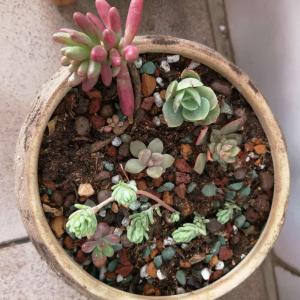
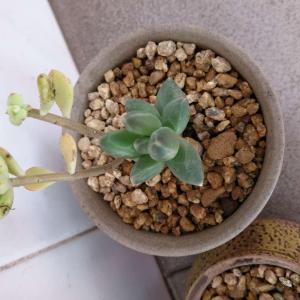



0
0
五花肉jia鱼:@xxxxylove 老板说和之松在一起的是小红旗,一个听都没有听过的品种
五花肉jia鱼:@xxxxylove 不是春上吧,春上要大一点
五花肉jia鱼:@浅昔 对,就是红化妆
xxxxylove:图二有春上、虹之玉锦、图三千代田之松、另一颗像柳叶莲华
浅昔:第一张貌似红化妆


